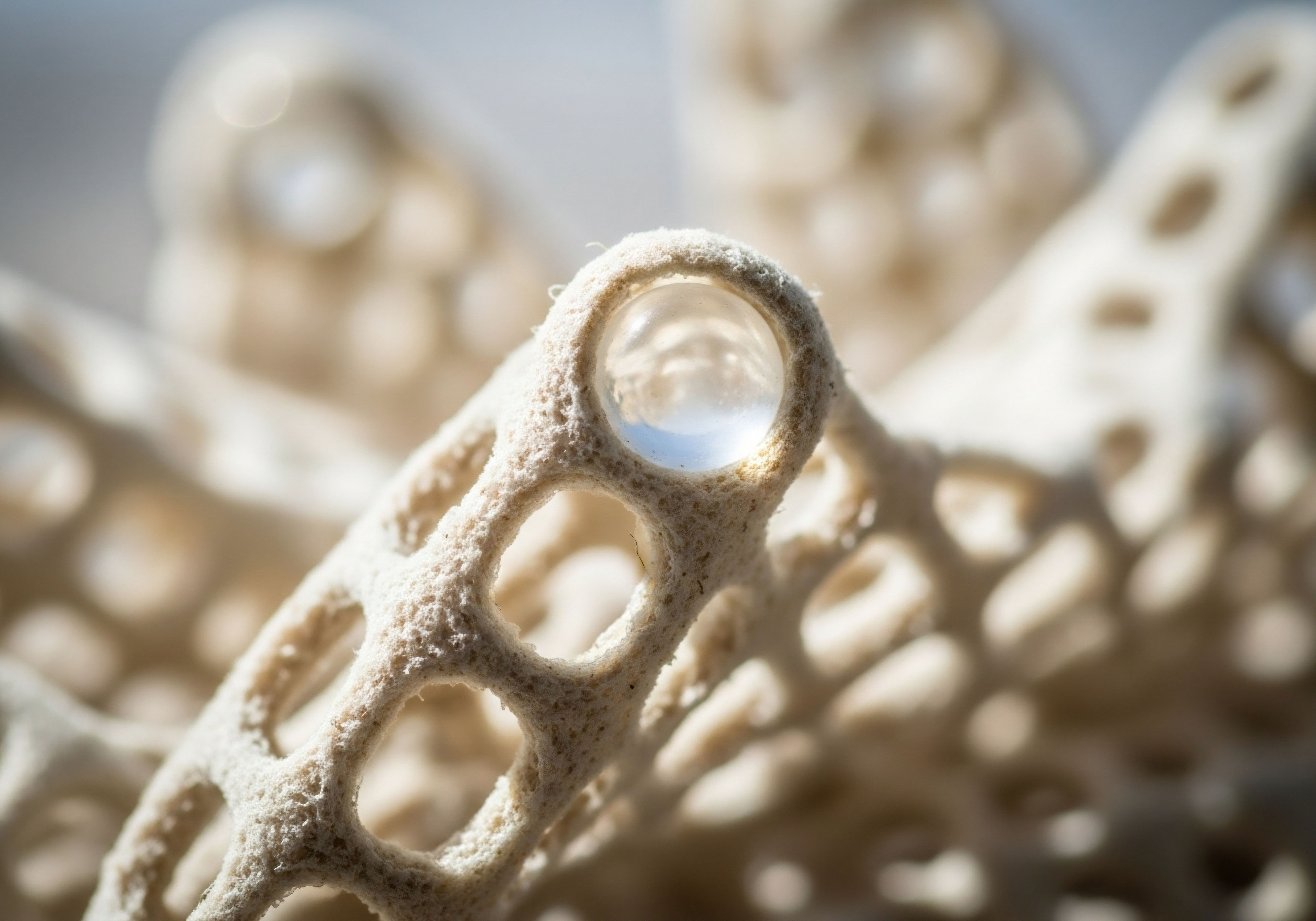

Fundamentals
Experiencing a decline in physical stamina, a persistent feeling of weariness, or a noticeable reduction in your ability to engage in activities you once enjoyed can be disheartening, particularly when managing a chronic cardiac condition. This lived experience, often marked by a struggle to maintain exercise capacity, is not merely a consequence of heart health alone.
Your body’s intricate internal messaging systems, specifically your endocrine system, play a significant part in shaping your vitality and functional reserves. We often attribute changes in physical output solely to the heart, yet a deeper understanding reveals a complex interplay where hormonal balance holds considerable sway.
For men, a key hormonal messenger is testosterone. This steroid hormone, primarily produced in the testes, acts as a fundamental regulator across numerous bodily systems. It influences muscle mass, bone density, red blood cell production, and even cognitive function. When the body produces insufficient amounts of this vital hormone, a condition known as hypogonadism arises.
This state extends beyond simple fatigue; it represents a systemic shift that can profoundly affect how your body generates and utilizes energy, directly impacting your capacity for physical exertion.
Diminished physical stamina in men with cardiac conditions may stem from hypogonadism, a hormonal imbalance affecting systemic energy and function.
The influence of testosterone extends to the very engines of your cells, the mitochondria, which are responsible for generating adenosine triphosphate (ATP), the primary energy currency of the body. Adequate testosterone levels support mitochondrial efficiency and biogenesis, ensuring your cells have the necessary power to perform.
When testosterone levels dip below optimal ranges, this cellular energy production can falter, contributing to feelings of lethargy and a reduced ability to sustain physical activity. This metabolic slowdown can be particularly challenging for individuals whose cardiovascular systems are already under strain.
Understanding the foundational role of testosterone in maintaining physical vigor is the initial step toward reclaiming a sense of robust health. It is not about isolating one system but recognizing how the endocrine system acts as a conductor for the entire physiological orchestra. Addressing hormonal imbalances, therefore, becomes a crucial component in supporting overall well-being and enhancing the capacity for movement and activity, even in the presence of existing cardiac considerations.

How Does Testosterone Influence Muscle Function?
Testosterone’s impact on muscle function is multifaceted, affecting both the quantity and quality of muscle tissue. It promotes protein synthesis, the process by which cells build new proteins, including those essential for muscle repair and growth. This anabolic effect is critical for maintaining muscle mass and strength, which are direct determinants of exercise capacity. Without sufficient testosterone, the body struggles to repair and rebuild muscle fibers effectively, leading to muscle wasting or sarcopenia, a condition that significantly impairs physical performance.
Beyond simply building muscle, testosterone also influences the nervous system’s ability to activate muscle fibers. It contributes to neuromuscular efficiency, ensuring that signals from the brain effectively translate into coordinated muscle contractions. This coordination is vital for movements ranging from walking to more strenuous exercise. A deficiency in this hormonal signaling can result in a perceived weakness or a lack of power during physical tasks, making even moderate activity feel exceptionally demanding.


Intermediate
When considering the intersection of hypogonadism and chronic cardiac conditions, a careful, clinically informed approach to hormonal optimization protocols becomes paramount. The goal is to restore physiological balance, not merely to treat a symptom in isolation. This requires a precise understanding of therapeutic agents and their systemic effects, particularly within the context of a delicate cardiovascular system.
Testosterone Replacement Therapy (TRT) for men with documented hypogonadism is a primary intervention. The standard protocol often involves weekly intramuscular injections of Testosterone Cypionate, typically at a concentration of 200mg/ml. This method provides a steady release of testosterone into the bloodstream, aiming to restore levels to a healthy physiological range. The administration frequency helps maintain stable hormone concentrations, avoiding the peaks and troughs that can occur with less frequent dosing.
Testosterone Replacement Therapy, carefully administered, aims to restore physiological balance in men with hypogonadism and cardiac conditions.
To mitigate potential side effects and support the body’s natural endocrine function, TRT protocols often incorporate additional medications. One such agent is Gonadorelin, administered via subcutaneous injections, typically twice weekly. Gonadorelin is a synthetic analog of gonadotropin-releasing hormone (GnRH), which stimulates the pituitary gland to produce luteinizing hormone (LH) and follicle-stimulating hormone (FSH). This helps maintain natural testosterone production within the testes and preserves fertility, which can be suppressed by exogenous testosterone administration.
Another important component is Anastrozole, an oral tablet taken twice weekly. Anastrozole acts as an aromatase inhibitor, blocking the conversion of testosterone into estrogen. While estrogen is essential for various bodily functions, excessive levels in men can lead to undesirable side effects such as gynecomastia, water retention, and potentially adverse cardiovascular effects.
Careful monitoring of estrogen levels is crucial to ensure optimal balance. In some cases, Enclomiphene may be included to support LH and FSH levels, offering an alternative or complementary approach to Gonadorelin for stimulating endogenous testosterone production.

Navigating Hormonal Optimization with Cardiac Considerations
The decision to initiate TRT in men with chronic cardiac conditions requires a thorough evaluation of individual risk factors and benefits. Clinical assessment involves comprehensive blood work, including baseline testosterone, estrogen, and other relevant metabolic markers. Regular monitoring is essential to adjust dosages and manage any potential adverse reactions. The aim is to achieve symptomatic improvement and functional gains while ensuring cardiovascular safety.
Consideration of existing cardiac medications and conditions is paramount. For instance, some cardiac medications might interact with hormonal therapies, necessitating careful dosage adjustments or alternative approaches. The dialogue between the patient and their clinical team is central to tailoring a protocol that supports both hormonal health and cardiovascular stability.
| Medication | Primary Purpose | Administration |
|---|---|---|
| Testosterone Cypionate | Testosterone replacement | Weekly intramuscular injection |
| Gonadorelin | Preserve natural testosterone production and fertility | 2x/week subcutaneous injection |
| Anastrozole | Block estrogen conversion | 2x/week oral tablet |
| Enclomiphene | Support LH and FSH levels | Oral tablet (as prescribed) |

Exploring Additional Peptide Therapies
Beyond traditional TRT, specific peptide therapies can offer complementary support for active adults and athletes, including those seeking to optimize their physical capacity in the context of cardiac health. These peptides work through distinct mechanisms to support various physiological processes.
- Sermorelin ∞ This peptide stimulates the pituitary gland to release growth hormone (GH). Increased GH levels can support muscle repair, fat metabolism, and overall tissue regeneration, contributing to improved body composition and recovery.
- Ipamorelin / CJC-1295 ∞ These are also growth hormone-releasing peptides, often used in combination. They promote a more natural, pulsatile release of GH, which can aid in muscle gain, fat loss, and sleep quality, all of which indirectly support exercise capacity.
- Tesamorelin ∞ Specifically approved for reducing visceral fat, Tesamorelin can be beneficial for metabolic health, which is closely linked to cardiovascular well-being and physical performance.
- Hexarelin ∞ Another GH secretagogue, Hexarelin can support muscle growth and fat reduction, contributing to enhanced physical conditioning.
- MK-677 ∞ An oral growth hormone secretagogue, MK-677 promotes GH release and can improve sleep, body composition, and recovery, offering systemic benefits for physical function.
Other targeted peptides address specific aspects of health that can influence exercise capacity. PT-141, for instance, is utilized for sexual health, which can be a significant aspect of overall well-being and motivation for physical activity. Pentadeca Arginate (PDA) is being explored for its potential in tissue repair, healing processes, and inflammation modulation. Reducing systemic inflammation and supporting tissue integrity can indirectly enhance recovery from exertion and improve overall physical resilience, particularly relevant for individuals managing chronic conditions.


Academic
The intricate relationship between hypogonadism and diminished exercise capacity in men with chronic cardiac conditions extends far beyond simple hormonal deficiency. It involves a complex interplay of endocrine signaling, metabolic pathways, and cellular bioenergetics, all operating within the context of a compromised cardiovascular system. A deep understanding requires dissecting the systemic effects of low testosterone at a molecular and physiological level.
The Hypothalamic-Pituitary-Gonadal (HPG) axis serves as the central regulatory system for testosterone production. The hypothalamus releases gonadotropin-releasing hormone (GnRH), which stimulates the pituitary gland to secrete luteinizing hormone (LH) and follicle-stimulating hormone (FSH). LH then acts on the Leydig cells in the testes to produce testosterone. This feedback loop ensures precise hormonal regulation. In men with chronic cardiac conditions, systemic inflammation, oxidative stress, and even certain medications can disrupt this delicate axis, leading to secondary hypogonadism.
Hypogonadism in cardiac patients reflects a complex disruption of the HPG axis, impacting cellular energy and systemic function.

Testosterone’s Influence on Skeletal Muscle Bioenergetics
Skeletal muscle is a primary determinant of exercise capacity, and its function is profoundly influenced by testosterone. Low testosterone levels contribute to a reduction in muscle protein synthesis (MPS) and an increase in muscle protein breakdown (MPB), leading to a net loss of muscle mass and strength.
This imbalance directly impairs the force-generating capacity of muscles. Furthermore, testosterone influences the expression of genes involved in muscle fiber type distribution, favoring type II (fast-twitch) fibers, which are crucial for power and high-intensity activities. A shift towards type I (slow-twitch) fibers or a reduction in overall muscle quality can significantly limit bursts of activity and overall endurance.
Beyond structural integrity, testosterone plays a critical role in mitochondrial function within muscle cells. It supports the biogenesis of new mitochondria and enhances the efficiency of existing ones, thereby optimizing oxidative phosphorylation, the process by which ATP is generated. Reduced testosterone can lead to mitochondrial dysfunction, characterized by decreased ATP production and increased reactive oxygen species (ROS) generation.
This cellular energy deficit manifests as muscle fatigue and reduced endurance, making sustained physical activity challenging for cardiac patients already facing oxygen delivery limitations.

Cardiovascular and Metabolic Interconnections
The impact of hypogonadism on exercise capacity in cardiac patients is compounded by its direct and indirect effects on the cardiovascular system and metabolic health. Low testosterone is associated with adverse changes in body composition, including increased visceral adiposity and reduced lean muscle mass. This shift contributes to insulin resistance and systemic inflammation, both of which are detrimental to cardiovascular health. Insulin resistance impairs glucose uptake by muscle cells, further limiting energy availability during exercise.
Testosterone also influences endothelial function, the health of the inner lining of blood vessels. Healthy endothelium is essential for vasodilation, allowing blood vessels to relax and expand, which is critical for delivering oxygen and nutrients to working muscles during exertion. Hypogonadism can impair endothelial function, leading to reduced blood flow and oxygen delivery, thereby limiting exercise capacity. Studies have indicated that testosterone replacement can improve endothelial-dependent vasodilation in hypogonadal men, suggesting a direct benefit for cardiovascular performance.
| System Affected | Mechanism of Impairment | Consequence for Exercise Capacity |
|---|---|---|
| Skeletal Muscle | Reduced protein synthesis, mitochondrial dysfunction | Decreased strength, increased fatigue, sarcopenia |
| Cardiovascular System | Endothelial dysfunction, increased inflammation | Impaired blood flow, reduced oxygen delivery |
| Metabolic Health | Insulin resistance, increased adiposity | Reduced glucose utilization, lower energy availability |
| Central Nervous System | Altered neurotransmitter activity | Increased fatigue perception, reduced motivation |
The systemic inflammatory state often observed in hypogonadal men can exacerbate existing cardiac conditions. Chronic inflammation contributes to atherosclerosis and myocardial dysfunction. Testosterone replacement has been shown to exert anti-inflammatory effects, potentially mitigating some of these adverse processes. However, the precise mechanisms and long-term cardiovascular outcomes in men with pre-existing cardiac disease remain an active area of clinical investigation, necessitating careful patient selection and rigorous monitoring.

The Role of Growth Hormone and Peptides in Recovery
Beyond testosterone, the growth hormone (GH) axis plays a significant role in tissue repair, metabolic regulation, and overall physical resilience. Peptides like Sermorelin and the combination of Ipamorelin / CJC-1295 stimulate the pulsatile release of endogenous GH from the pituitary gland. This naturalistic approach avoids the supraphysiological levels associated with exogenous GH administration.
The benefits for exercise capacity stem from enhanced protein synthesis, improved fat oxidation, and accelerated recovery from physical stress. For men with chronic cardiac conditions, optimizing recovery and reducing metabolic burden can be particularly advantageous.
Tesamorelin, a GH-releasing factor, has demonstrated specific efficacy in reducing visceral adipose tissue, a metabolically active fat depot strongly linked to cardiovascular risk. By improving body composition and reducing central obesity, Tesamorelin can indirectly enhance exercise tolerance and reduce the metabolic strain on the heart.
Similarly, peptides such as Pentadeca Arginate (PDA), with its reported tissue repair and anti-inflammatory properties, could theoretically support the recovery of muscle and connective tissues, which are under increased stress during physical activity, especially in individuals with underlying health challenges. These advanced protocols represent avenues for comprehensive physiological support, always requiring individualized clinical assessment.

References
- Mooradian, Arshag D. et al. “Biological actions of androgens.” Endocrine Reviews, vol. 8, no. 1, 1987, pp. 1-28.
- Traish, Abdulmaged M. et al. “The dark side of testosterone deficiency ∞ II. Type 2 diabetes and insulin resistance.” Journal of Andrology, vol. 30, no. 1, 2009, pp. 23-32.
- Jones, H. et al. “Testosterone and endothelial function in men with chronic heart failure.” Heart, vol. 91, no. 10, 2005, pp. 1327-1328.
- Basaria, Shehzad, et al. “Effects of testosterone replacement on muscle strength and body composition in men with chronic heart failure.” Journal of the American College of Cardiology, vol. 40, no. 10, 2002, pp. 1825-1833.
- Isidori, Andrea M. et al. “Effects of testosterone on body composition, bone metabolism and serum lipid profile in middle-aged male patients with mild hypogonadism ∞ a placebo-controlled randomized study.” Clinical Endocrinology, vol. 63, no. 3, 2005, pp. 280-287.
- Boron, Walter F. and Emile L. Boulpaep. Medical Physiology. 3rd ed. Elsevier, 2017.
- Guyton, Arthur C. and John E. Hall. Textbook of Medical Physiology. 14th ed. Elsevier, 2020.
- Vance, Mary L. and Michael O. Thorner. “Growth hormone-releasing hormone ∞ clinical review.” Trends in Endocrinology & Metabolism, vol. 10, no. 1, 1999, pp. 12-18.
- Sattler, Wolfgang, et al. “Growth hormone and exercise.” Journal of Applied Physiology, vol. 107, no. 4, 2009, pp. 1302-1309.

Reflection
Your personal health journey is a dynamic process, one that calls for a deep, intuitive understanding of your body’s signals. The knowledge shared here about hypogonadism and its connection to exercise capacity in the context of cardiac health serves as a starting point, a framework for deeper introspection. It invites you to consider how your internal systems, particularly your endocrine balance, might be influencing your daily vitality and functional capabilities.
This exploration is not an endpoint but an invitation to a more informed dialogue with your healthcare providers. It prompts you to ask more precise questions, to seek out comprehensive assessments, and to consider personalized strategies that extend beyond conventional approaches. Reclaiming your vitality and optimizing your physical function is a deeply personal undertaking, one that benefits immensely from a collaborative and evidence-based approach tailored specifically to your unique biological blueprint.

Considering Your Unique Biological Blueprint?
Every individual’s physiology is distinct, shaped by genetics, lifestyle, and existing health conditions. This means that while general principles apply, the precise application of hormonal optimization protocols requires careful individualization. What works for one person may not be optimal for another. This underscores the importance of a detailed clinical evaluation, including comprehensive laboratory testing and a thorough review of your medical history.
The path to enhanced well-being involves understanding your body’s current state and then strategically supporting its innate capacity for balance and repair. This journey is about partnership ∞ between you and your body, and between you and a clinical team dedicated to translating complex science into actionable steps for your sustained health.



